Want to make an all-natural laundry detergent as effective as commercial detergent? Your search is over. Here’s how to make the best DIY homemade laundry detergent. And all you need is 3 key ingredients and 15 minutes.
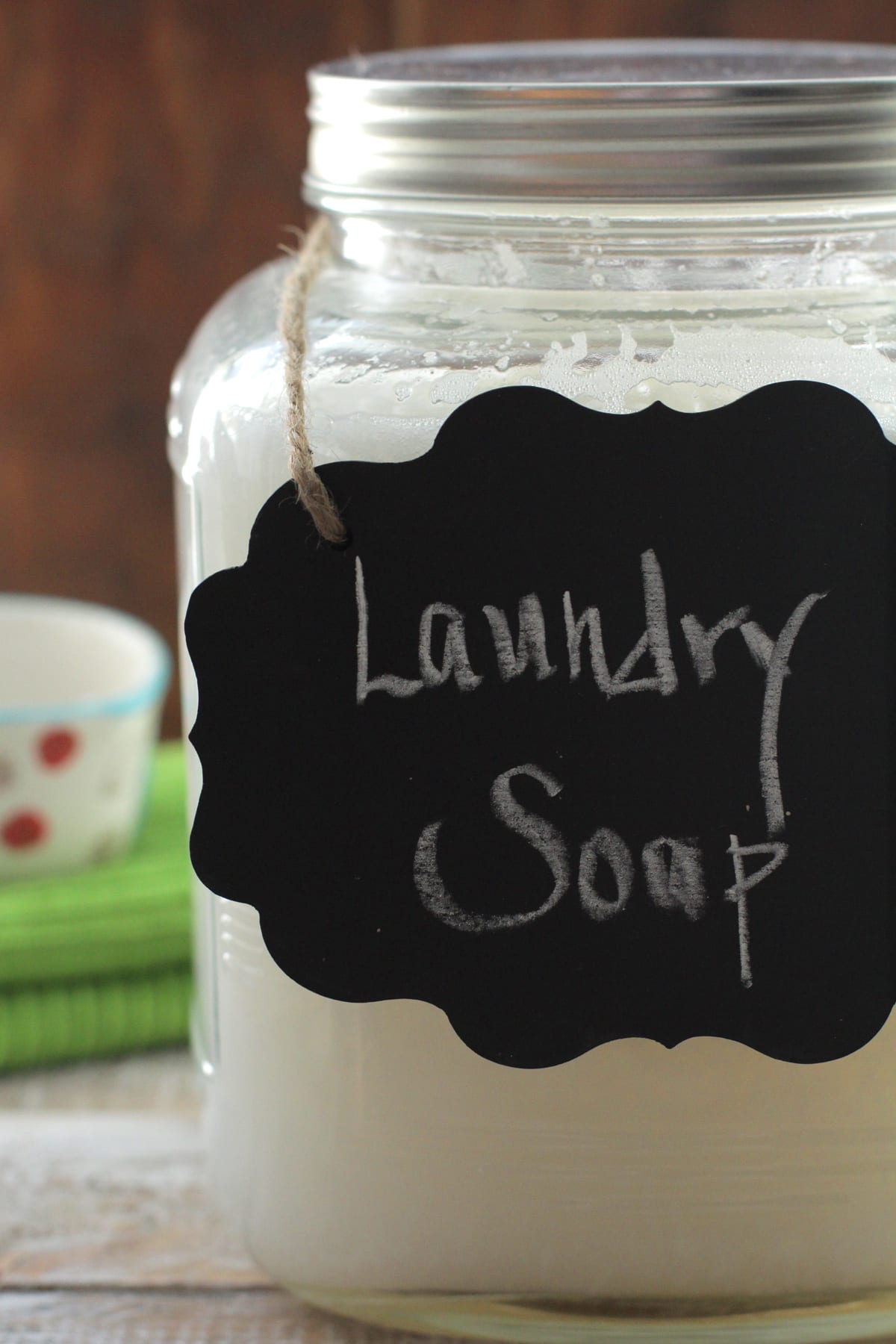
Want to Save This Article?
Enter your email & I’ll send it straight to your inbox. And you’ll get new recipes & tips each week.
11 years ago, I started making the switch to natural cleaning products, including laundry detergent!
At that time, the majority of recipes online called for a bar of fels naptha, washing soda, and Borax. But there was one problem: our clothes came out with chalky white spots.
So I made a simple swap: liquid Dr. Bronner’s castile soap instead of the fels naptha soap bar. With this one change, the detergent worked just as good as Tide.
This recipe is non-toxic, fights stains better than commercial detergent, and is cheap! I’ve been making this liquid laundry detergent for over 11 years (originally created in 2014) because of its extraordinary cleaning power.
Homemade Laundry Detergent Benefits
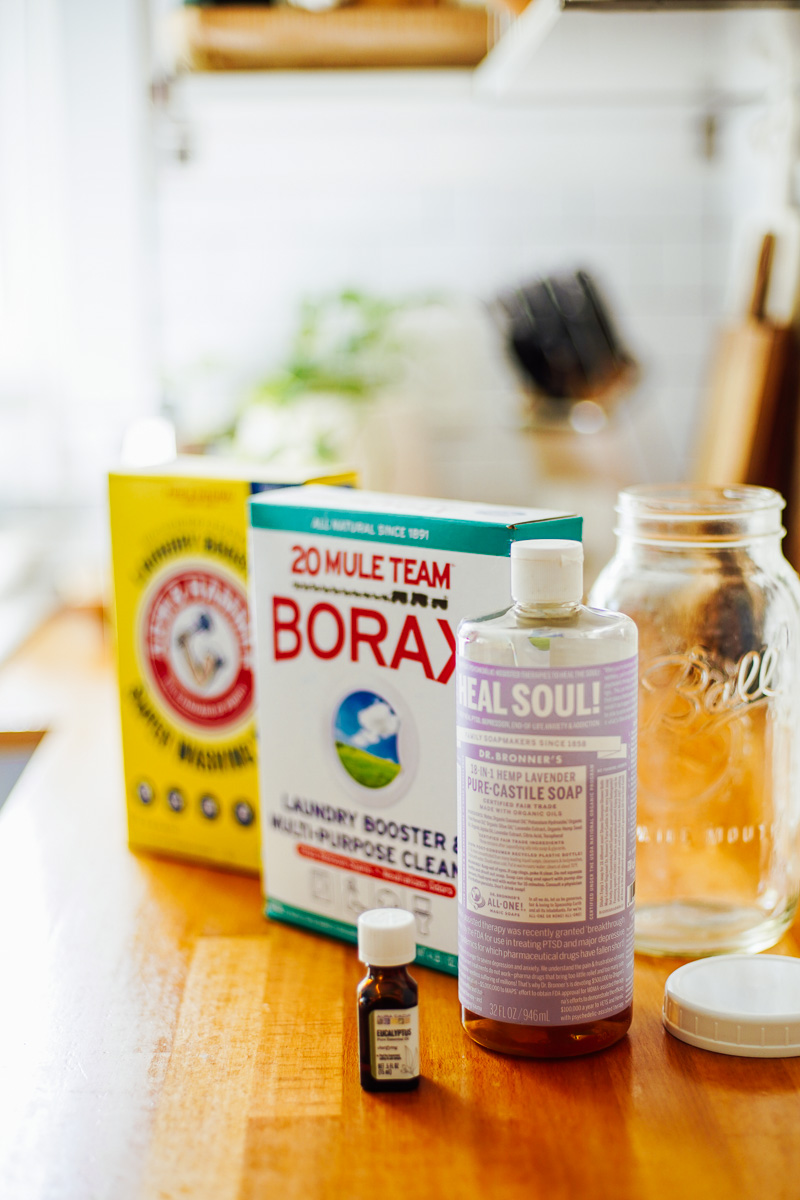
Before You Get Started: What You’ll Need
Ingredients
This recipe, made with simple ingredients, makes 1 gallon of homemade soap.
- 1 cup borax – freshens, deodorizes, and lifts dirt and stains
- 1 cup washing soda – freshens and deodorizes
- 1 cup liquid castile soap or Sal Suds – the main cleaning agent, lifts dirt and cleans
- 50 drops essential oil – optional for a scent
- 15 cups water – distilled water, found in any grocery store, is best as it doesn’t contain containments found in tap or filtered water
Equipment
- Large saucepan or Dutch oven – enough to hold 1 gallon of liquid, 15 cups
- Storage Jars – such as 2 half gallon-size glass mason jars, 1 gallon-size jar, or reuse an old detergent bottle
Thicker Detergent Tip: This recipe calls for 15 cups of water. If you’d like a thicker, more concentrated soap, use 10-12 cups of water.
How to Make Homemade Laundry Detergent: Recipe Steps
- Step 1 Boil 6 Cups of Water: In a large saucepan or Dutch oven, bring 6 cups of water to a slight boil. Once the water begins to boil, turn off the burner.
- Step 2 Add Borax, Washing Soda, More Water, and Castile Soap: Add the Borax and washing soda. Stir to dissolve. Then add 9 cups of room-temperature water and 1 cup of liquid castile soap. Give the ingredients a stir to combine.
- Step 3 Cool for 5-10 Minutes: Allow the soap to cool for a few minutes before pouring into one large gallon-size jar or smaller containers, like quart-size jars. Make sure your jar(s) are heat-safe. If not, wait until the soap is cool, then spoon the soap into the jar(s).
- Step 4 Add Essential Oil For Scent: Add an essential oil of choice (if using) to the soap (now in the jar) and stir to combine with the detergent.
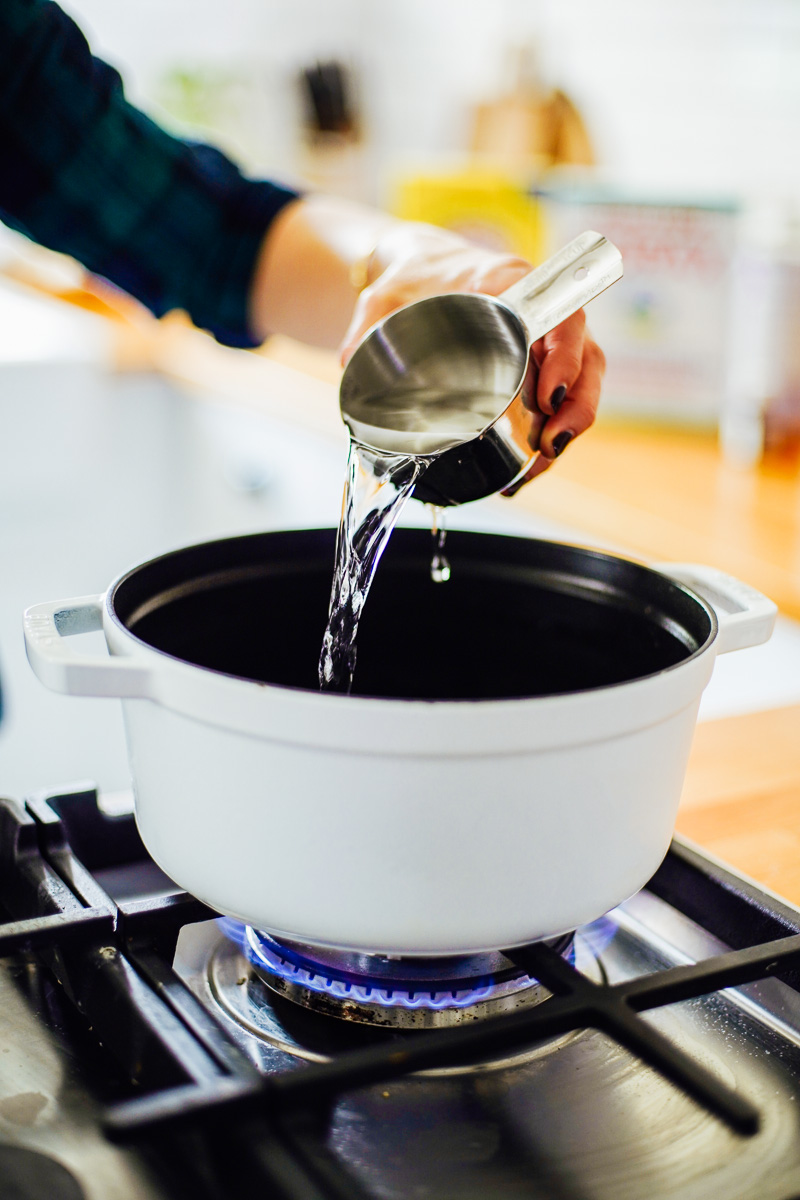
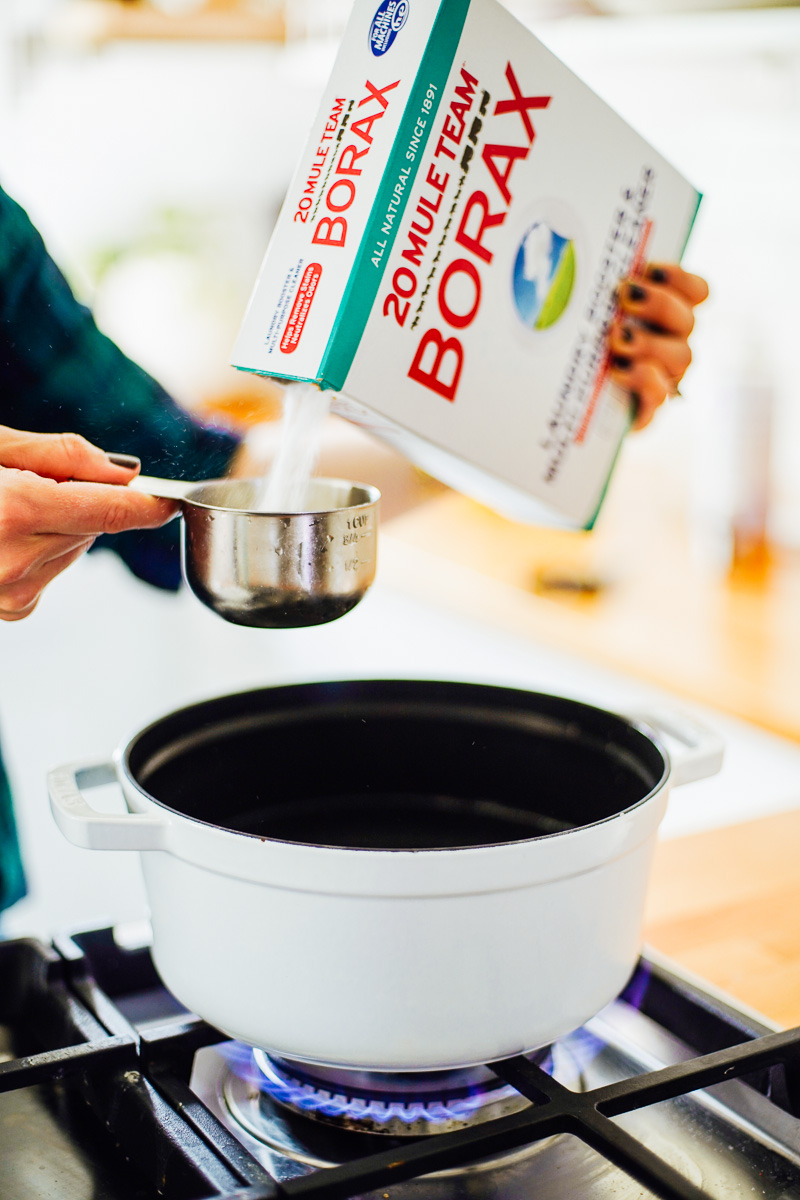
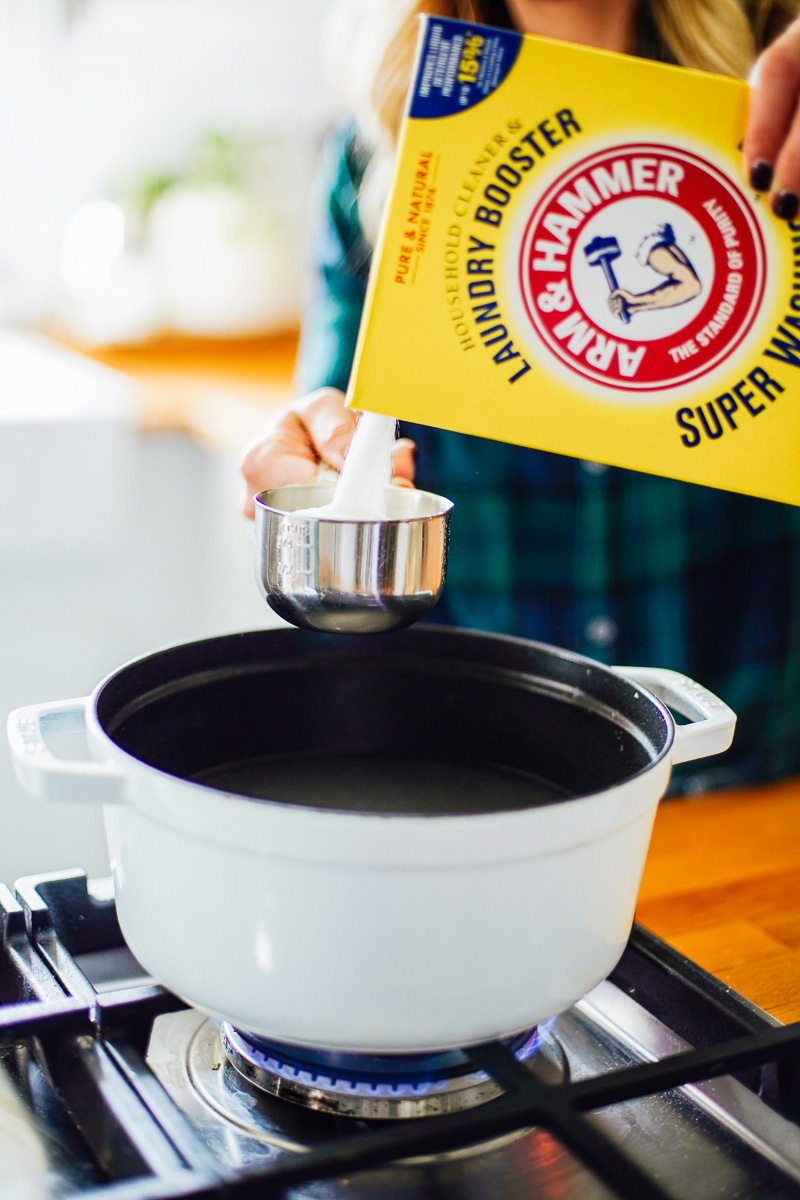
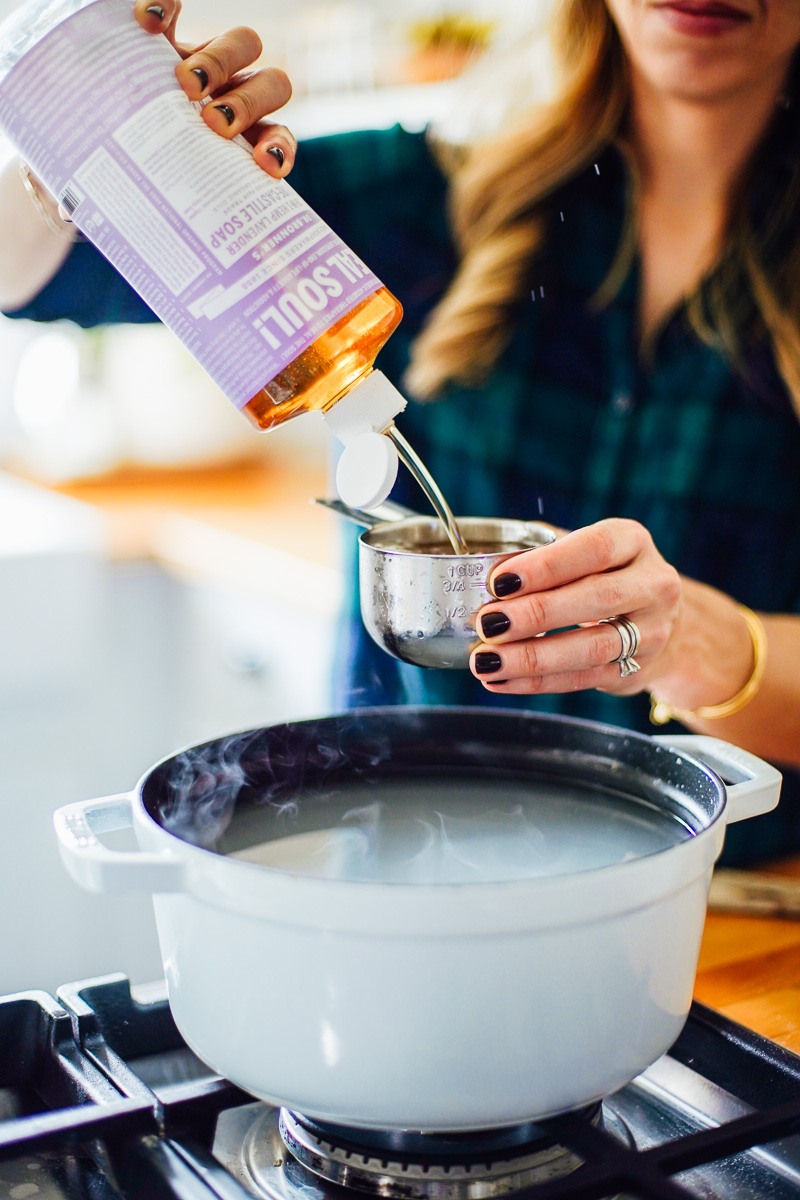
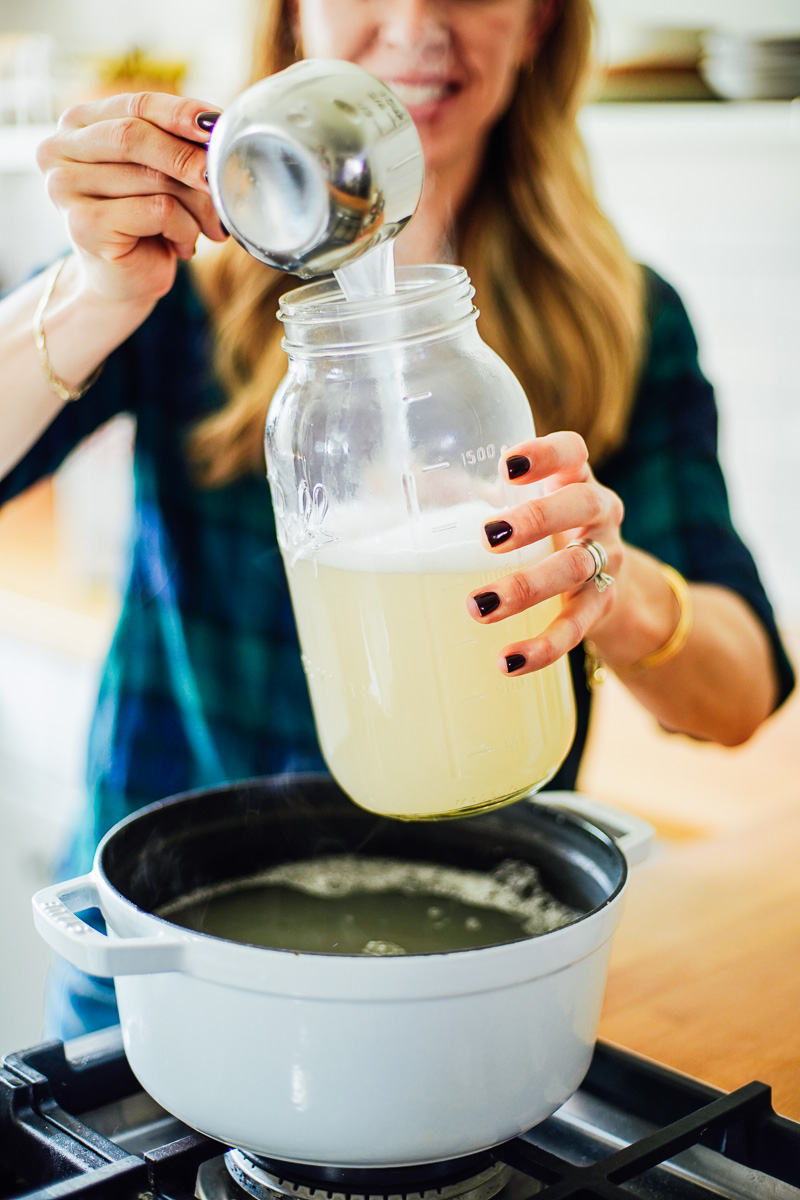
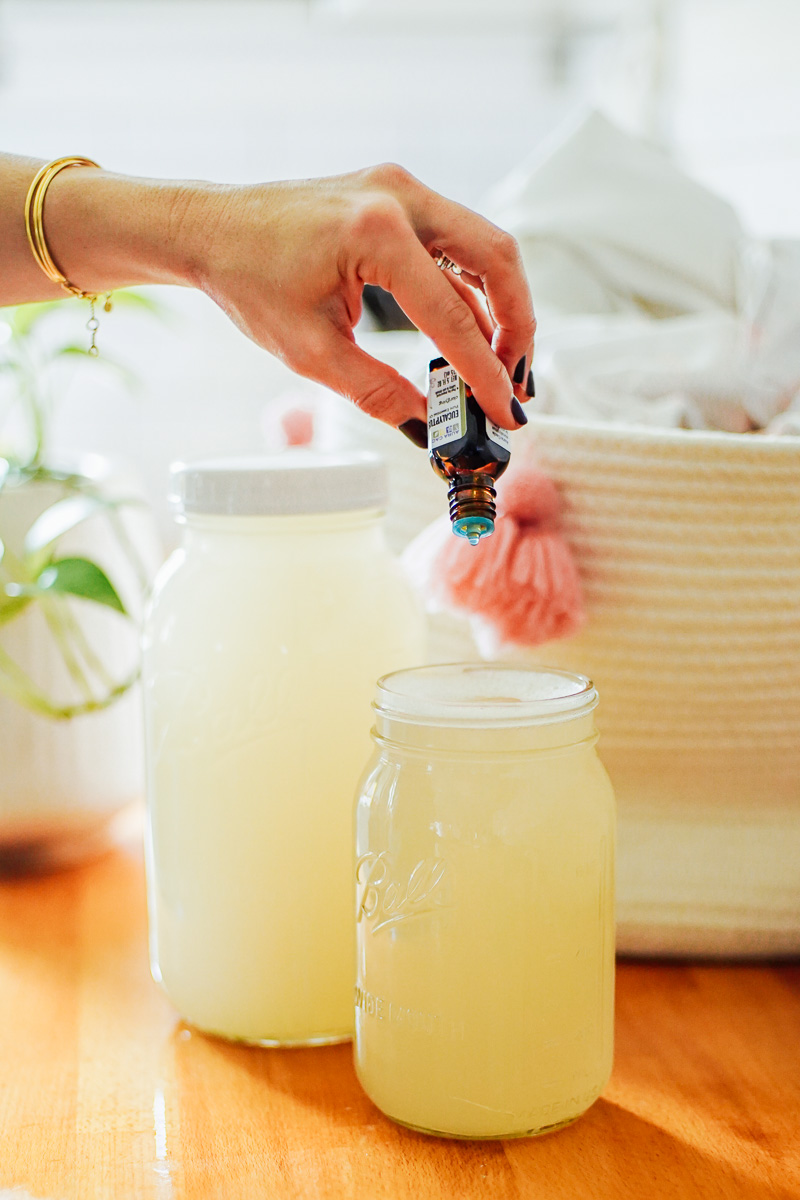
What to Avoid Doing
- Baking Soda – Don’t use baking soda in place of washing soda. Washing soda has a different chemical composition and will not work in this recipe. It is NOT a substitute.
- Dish Soap – Don’t use other dish soaps in place of the castile soap. Dish soap will cause the soap to have too many bubbles in the wash.
- Lack of Suds – Don’t assume that a lack of suds and bubbles means the soap isn’t effective. Suds and bubbles don’t equal clean.
- Plastic Containers – If you’re reusing an old detergent bottle for storage, make sure the laundry detergent is fully cool before adding to a plastic container.
- Heat-Safe Glass – Use a heat-resistant glass jar (if using glass for storage), and also allow the detergent to cool a bit (about 10 minutes) before adding it.
- Essential Oils – The essential oil will add a subtle fragrance, but shouldn’t be added until the soap cools as heat will cause the essential oil to evaporate.
How to Prevent Chunky or Gelled Detergent
After a few days the liquid laundry detergent may clump or gel. This is a completely normal chemical reaction that is usually caused when the outside temperature is cooler. There’s no way to completely prevent this from happening; however, one option is to use more water (2-3 cups more) to make a less concentrated soap.
The laundry soap is 100% usable if it gels up (l actually love this form). Simply scoop the detergent from the container and add to the washer.
Key Takeaway: Whether the laundry detergent gels up or remains liquid, it’s 100% effective and usable in both forms.
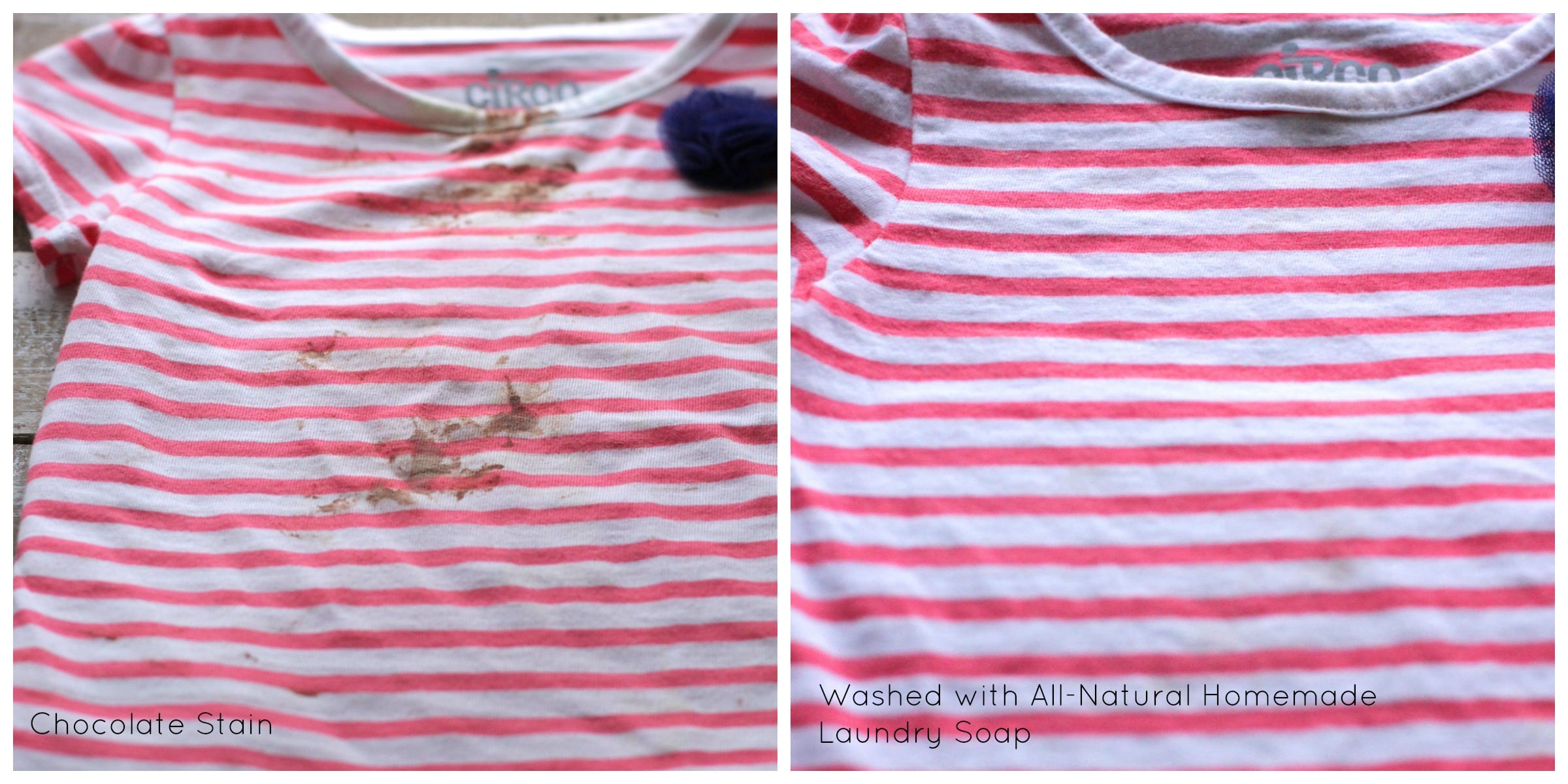
How to Use This Liquid Laundry Soap
The detergent is ready to use immediately after making. And may be stored for later use.
- Give the jar a good shake or stir (with a long spoon) before use.
- Use this detergent just as you would any laundry soap to clean clothes.
- This homemade liquid laundry soap is highly concentrated, which means you need only a tiny amount to get a dirty job done.
- For top-loading washer machines, use 1/8-1/4 cup.
- For an HE front loader, use 1-2 tablespoons.
- Add the detergent directly to your washer or the laundry soap compartment.
Can I use this in an HE washer?
I do, so I can only speak to my personal experience. I use 1-2 tablespoons per load. If it’s in gel form, add it straight to the washer on top of the clothes.
Always consult your machine’s user guide before using any laundry detergent to know what your machine can and can’t handle.
How long does this recipe last?
- Use the soap within 1 month.
- Store in your laundry room, at room temperature.
- Learn more about the safety of making your own natural cleaners.
FAQs
- Can I use a castile soap bar instead of liquid castile soap? Yes, you can. Use a cheese grater to grate a bar of castile soap into the hot water (along with the borax and washing soda). Stir and continue to boil the ingredients to dissolve fully (takes about 10 minutes). I also use a bar of castile soap to make powder laundry soap.
- Is it normal that it’s more watery than soapy? Yes, this is normal. For a thicker, more concentrated detergent, there are two options: use Sal Suds instead of castile soap OR reduce the water to 10-12 cups for a more concentrated detergent.
- The detergent is chunky (or gelled) after cooling, is that normal? Yes, this is normal. Depending on your home’s temperature, the soap may be more liquid or even chunky (like a gel). Both are normal and usable!
- My laundry soap didn’t gel. What happened? If your environment is cooler, your laundry soap may gel after cooling. Or it may not. This is normal. Both forms are 100% good and usable. A reader recently shared this tip you can try as well, “I also like the the detergent to be more gelatinous and I use my immersion blender for a few seconds after it is cool to whip it. It turns white and jelly.”
- Is borax safe? Borax is a debated ingredient in naturally-minded circles. I personally don’t see any reason to avoid it. This borax article from Wellness Mama has fantastic information.
- Can I use this soap to lift stains? Yes, you can. You can either add the garment to the washer or add the garment to your kitchen sink with the soap and water and soak the garment to lift the stains. Or, apply the soap directly to the stain and scrub. If you’re dealing with tough stain, I recommend using this homemade stain remover before washing the garment.
- Does this soap work with hard water? Yes, it does. I have hard water and this soap works great. You may want to use this laundry softener recipe as well.
Conclusion: Does this detergent work?
People always ask me, “Will homemade soap work as well as a store-bought product?” The answer, “YES! It will.”
My daughter’s chocolate stain on the left and after using this detergent in the wash. The stain lifted and the shirt was saved. If you need need extra help lifting a stain, you can also use my homemade stain remover first.
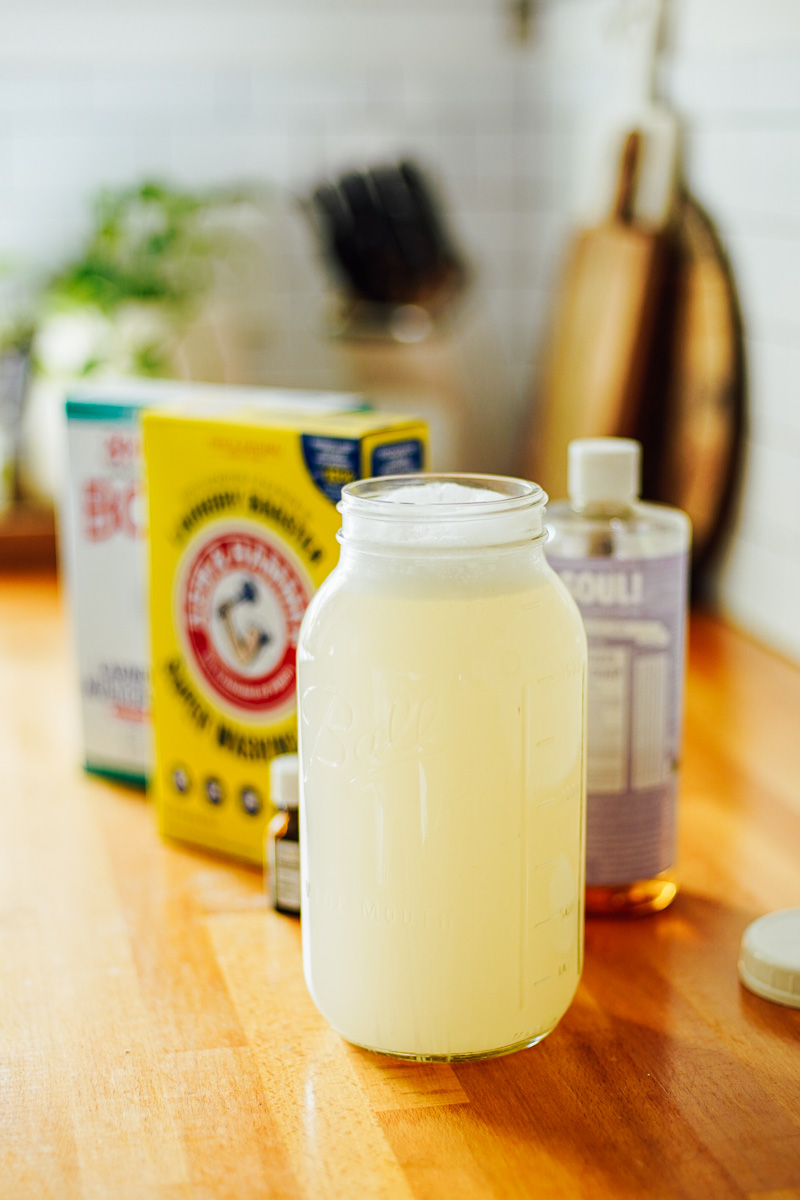

The Best Natural Laundry Detergent Brands: I’ve researched and tried many different laundry soap brands and narrowed down the best 11 brands!
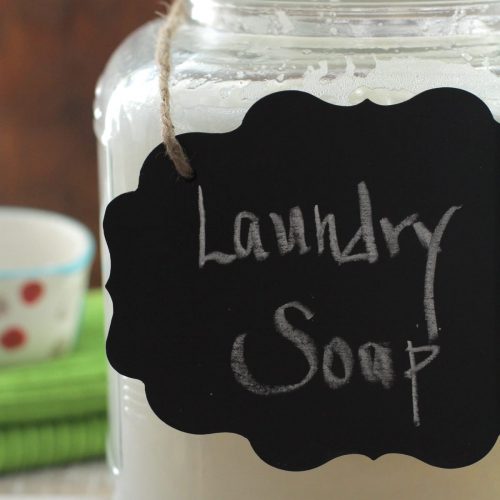
Homemade Liquid Laundry Detergent Recipe
Equipment
- 1 large saucepan or dutch oven (big enough to hold 15 cups of liquid)
- storage jars (such as 2 half gallon-size glass mason jars, 1 gallon-size jar, or reuse an old detergent bottle) for storing the laundry soap
Ingredients
- 1 cup borax
- 1 cup washing soda
- 1 cup liquid castile soap unscented or scented
- 15 cups water divided
- 50 drops essential oil optional for scent
Instructions
- In a large saucepan or Dutch oven, bring 6 cups of water to a slight boil. Once the water begins to boil, turn off the burner.
- Add the Borax and washing soda. Stir to dissolve. Then add 9 cups of room-temperature water and 1 cup of liquid castile soap. Give the ingredients a stir to combine.
- Allow the soap to cool for a few minutes before pouring into one large gallon-size jar or smaller containers, like quart-size jars. Make sure your jar(s) are heat-safe. If not, wait until the soap is cool, then spoon the soap into the jar(s).If you're reusing an old detergent bottle, make sure the soap is fully cool before adding to a plastic container.
- Add an essential oil of choice (if using) to the soap (now in the jar) and stir to combine with the detergent. The essential oil will add a subtle fragrance, but shouldn't be added until the soap cools as heat will cause the essential oil to evaporate.
- As the soap sits, the mixture may form into a gel and become chunky. There may also be liquid and gel separation, simply stir or shake. This is normal.
How to Use
- For top loading washer machines, use 1/8-1/4 cup. For a front loader, use 1-2 tablespoons. Add the detergent to the liquid soap compartment of the washer.
- Stain Treatment – Use a small amount of soap directly on the stain, scrub or rub the stain with a cloth. Repeat as needed, then wash the garment. Or use this stain remover spray.
- Laundry Softener – This laundry detergent may be used with a fabric softener. I use vinegar added to the softener compartment or this salt scent booster & softener added directly to the wash basin before running a wash cycle.

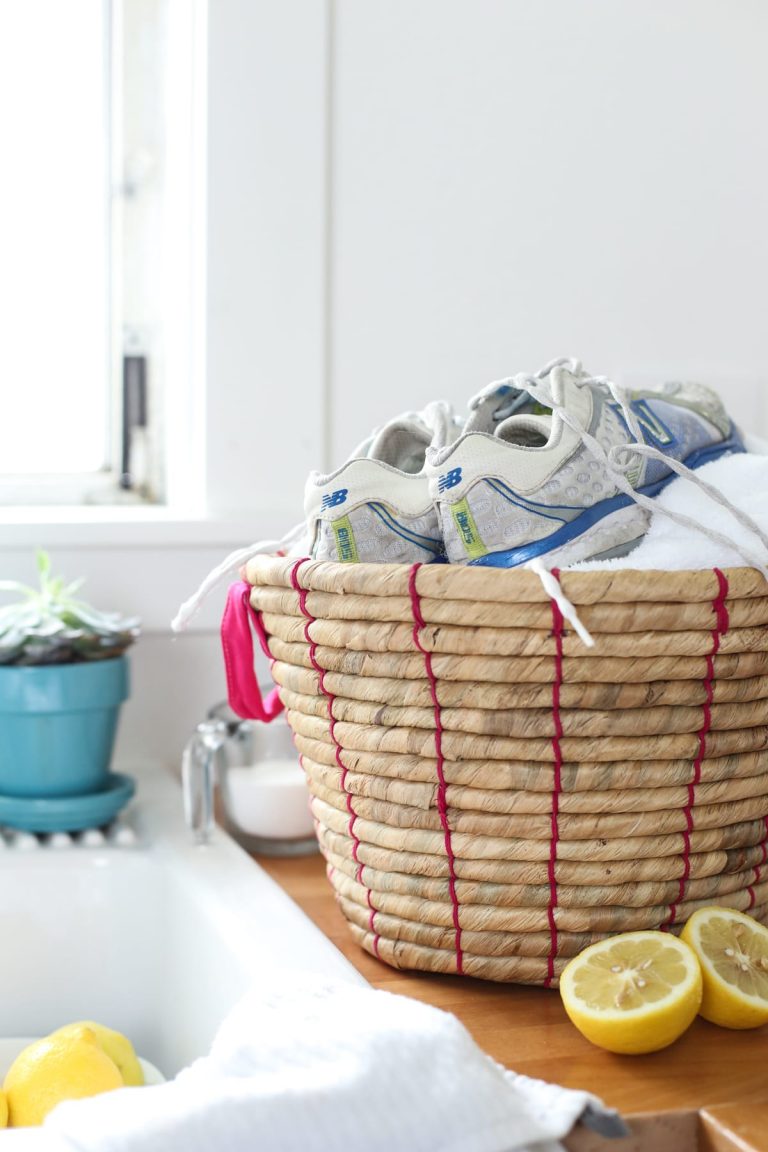
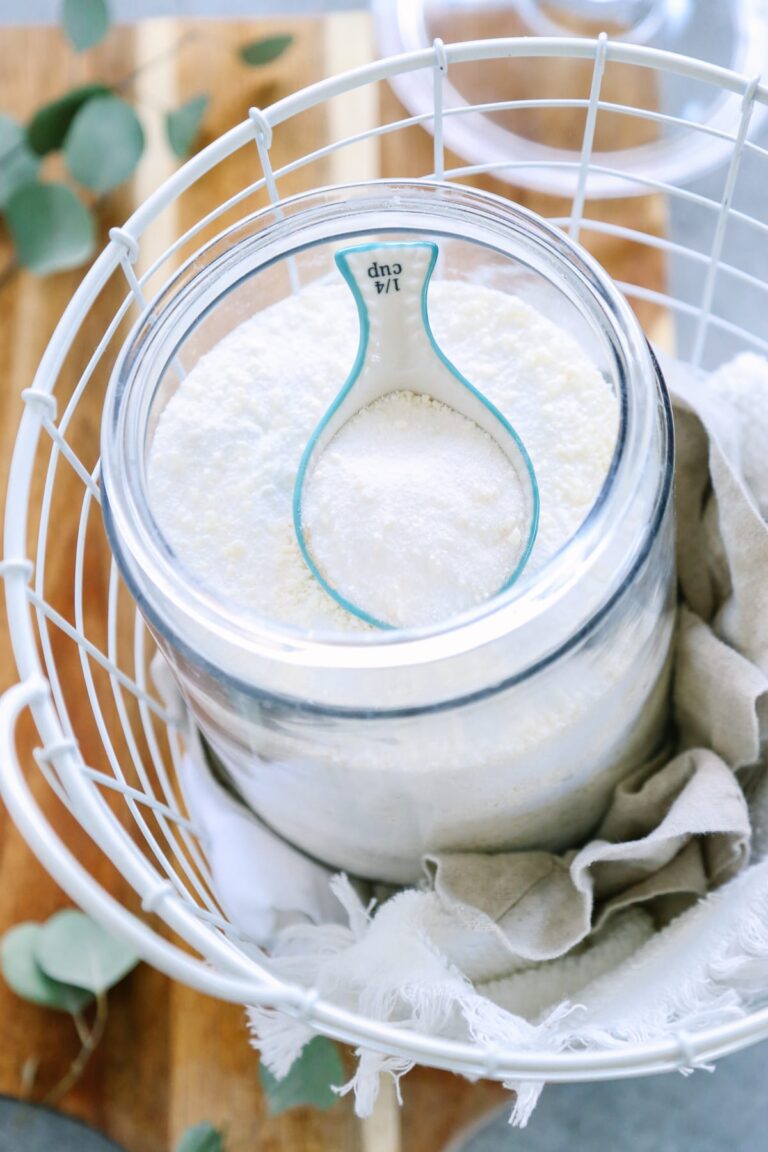
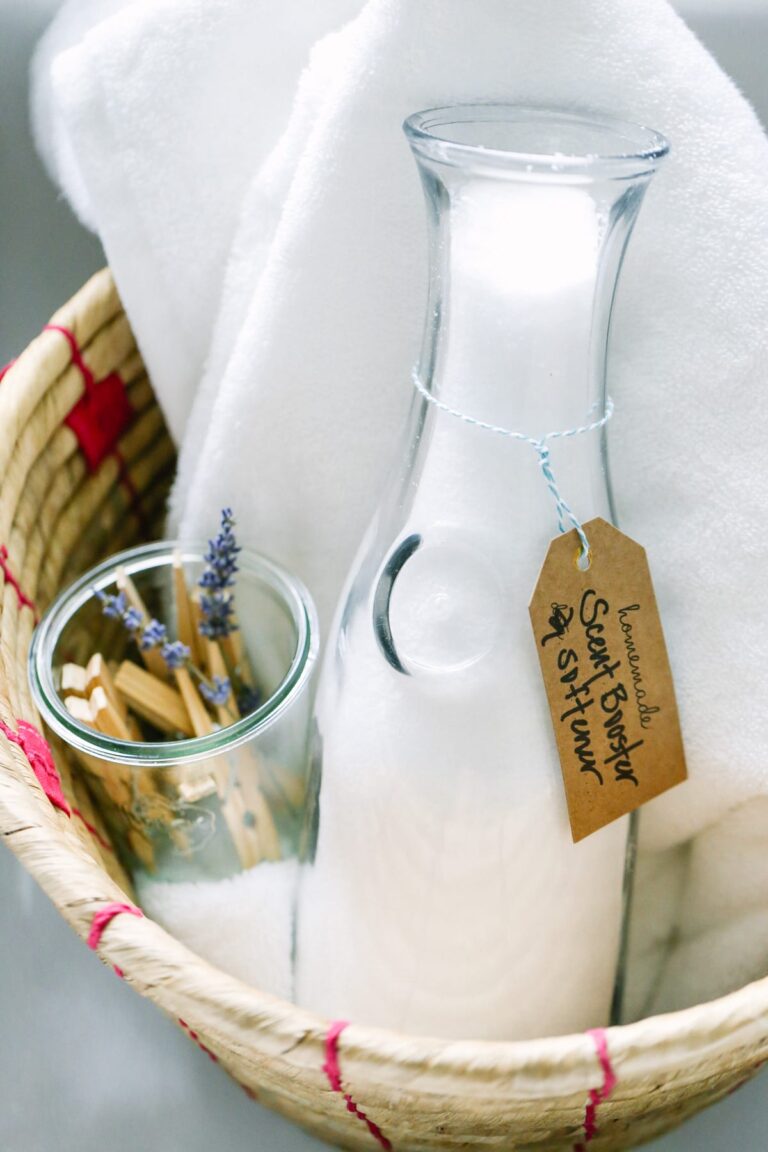

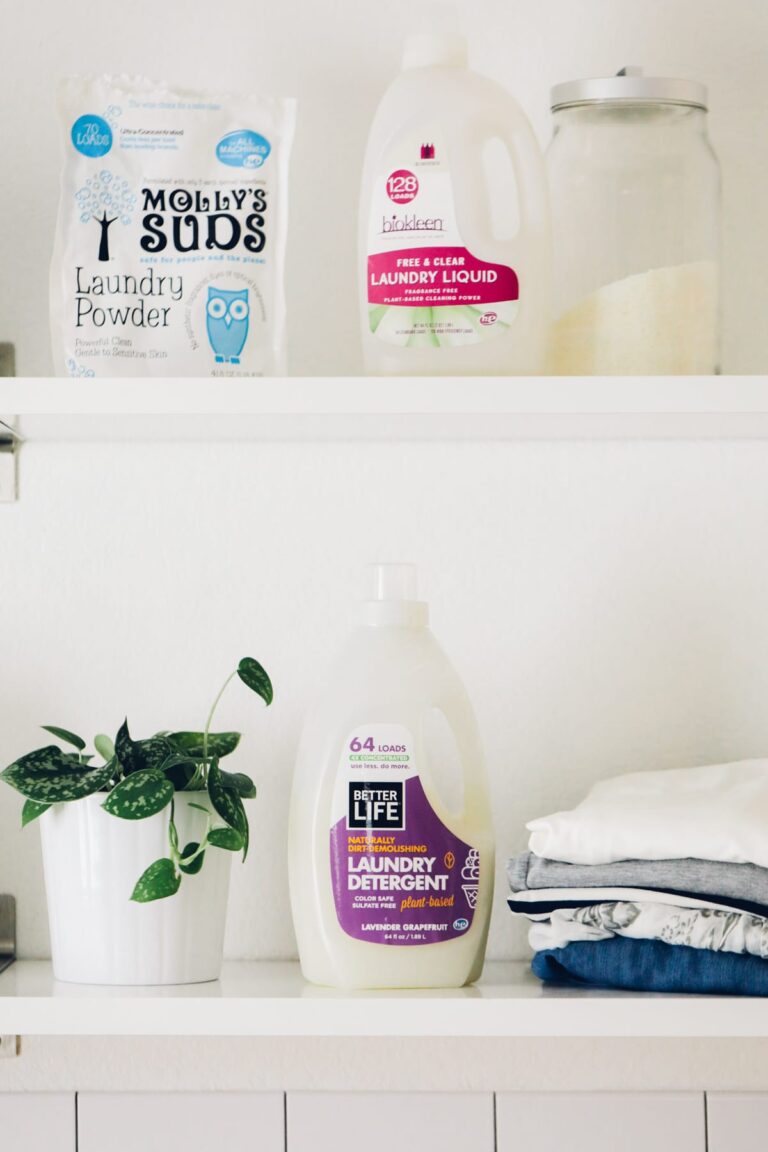
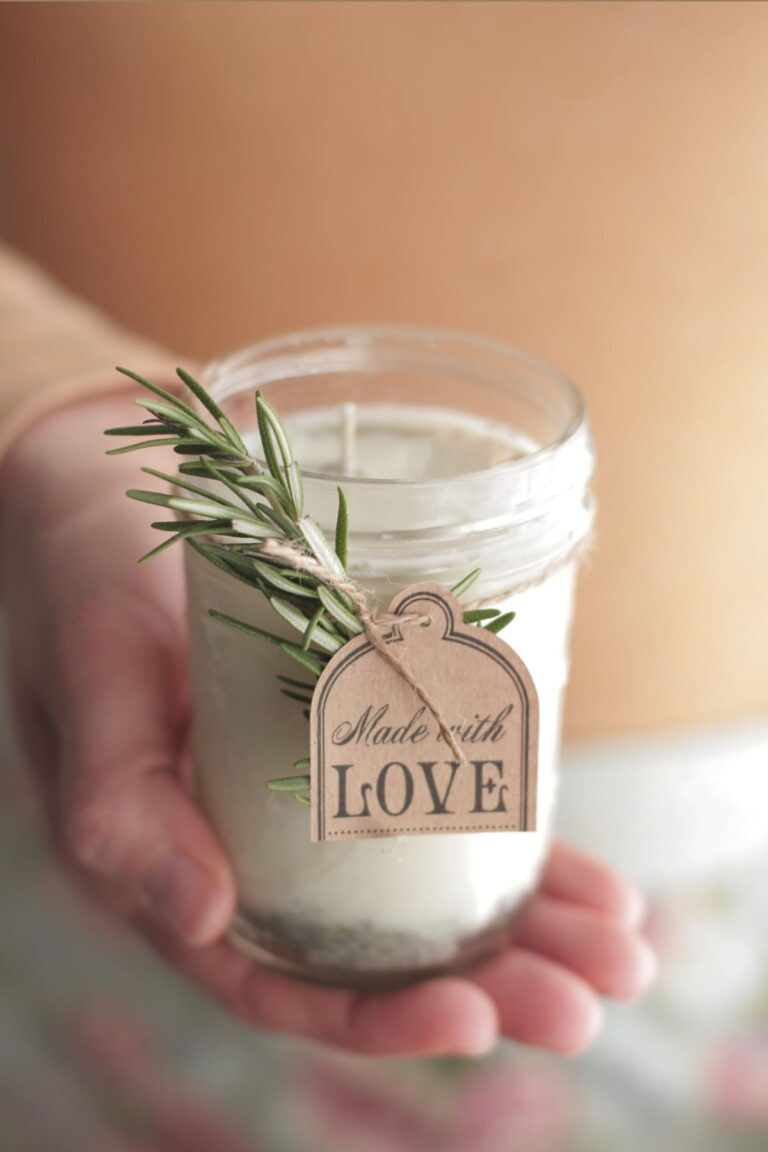
Hi Kristin! Thanks for the recipe, can’t wait to try it. I just have one question for you, I can’t seem to find any answers online. While I LOVE Dr. Bronners, recently I happened upon the Mrs. Meyers brand at the grocery store. I did a quick test on my countertop and it doesn’t produce any suds at all, but it also didn’t leave any kind of film on my laminate countertop so that was good. It was also WAY cheaper which was why I thought I’d give it a try. Have you every tried it or do you know anyone who has? It has a nice smell, I got the Lavender scented one and I do suspect that the fragrance is artifical. I used it in my carpet cleaner and to mop the kitchen so far, but a little iffy about putting it in my laundry soap. I have about a quarter bottle left of my Castile soap so I’ll probably try that first, and then try the Mrs. Meyers and see if its as good. I wanted to buy Dr. Bronners Sal Suds but can’t seem to find it anywhere.
Hey Kim, I have tried Mrs. Meyers before, and I’ve really enjoyed their cleaning products. From an ingredients standpoint, they aren’t that bad–although like you mentioned I’m not sure about their scents and how they’re derived. According to the EWG, most of their products receive a B grade: http://www.ewg.org/guides/brand/6630. They make a laundry detergent, so I would probably use that product if you want to stick with Mrs. Meyers. I’m not sure if their soap products will be effective, like castile soap, at making a homemade laundry soap. Castile soap is very concentrated, so it’s important to dilute it. I’m not sure if Mrs. Meyers will work the same way.
Hi Kristin,
I’m sorry if you’ve answered this in the comments, but I am in a super hurry right now and don’t have time to read them all (there are a LOT!). I noticed in your recipe for the dry detergent, you have a recommended amount for top loaders and front loaders. Is there a different amount for front/top loaders with this recipe? I have a front loader and am trying this recipe for the first time. Thank you. Love your site and can’t wait to try several of these DIY home products.
Hey Karen, Lol, there are a lot of comments ????. I’m happy to answer this question, and I need to go back into this post and edit/add the recommendations for top and front loaders. You can use this in a front loader, but since they use less water you’ll want to reduce the amount used to just 1-2 Tablespoons. Enjoy!!
Thank you for the laundry soap recipe. I have been making diy laundry soap and homemade deodorants for over a year. I use Dr. Bronner’s soaps for almost everything. I like only having to buy a few ingredients for my cleaning needs. I was worried at first that the finished laundry soap was too thin, but it settles and thickens with time. It doesn’t suds up, but does a nice job cleaning. Another bonus I have found is that the family is not experiencing mosquito and tick bites with the peppermint Dr. Bronner’s. This includes my dogs; I wash their bedding with it too, and haven’t had fleas in the warm season.
Hey Sharon, That’s so great! I’m curious to try out the peppermint scented soap in my next batch of soap. Living in Florida means we deal with a major mosquito issue all summer long. Thank you for sharing!
My washing soda and borax fizzed up everywhere so lost half of it
did you turn the burner off before you added them? i barely let it boil, barely, then shut off the burner and add them. i have an old whisk i keep in my laundry soap and i stir them in quickly with it to dissolve them. i’ve never had this happen. i’ve been using this recipe now for maybe 3, possibly longer, years.
Hey Deborah, Hmmm, it sounds like there was a chemical reaction–similar to when you mix baking soda and vinegar. I’m not sure what would have caused this.
Whoops I didn’t heat it at all, just mixed it all together. Does the heating just help the borax/ washing soda dissolve or will it not work as well since I didn’t heat it? Should I heat the whole mixture?
Hey Shannon, Yes, the heating should help dissolve the borax and washing soda. You could also add a bit more water to the current mixture (1/4 cup) and heat. I don’t think the heat will destroy the Sal Suds, just keep the heat below boiling.
You may have already answered this question—-but thats a lot of comments to read!!!! I was wondering if your liquid laundry soap recipe is okay for HE washers?
Hey Kristie, Lol, there are quite a few comments to read through ????. This will work in an HE machine. You’ll only need about 1-2 tablespoons versus 1/4 cup.
Just another perspective on borax and its safety and health benefits for consideration: http://www.health-science-spirit.com/borax.htm 🙂
Thanks, Kitty!
Just made my first batch of laundry soap and had a question….When I pour the soap into my washing machine when the water is pouring in, it doesn’t form any bubbles or lather. Is it supposed to?
Hey Mary, Homemade soap won’t form bubbles. Commerical detergents add ingredients to create the bubbles.
Hey Kristin –
My husband and I made the this detergent this past fall, and recently made our next batch. Has this recipe changed since the past fall? Did it used to include baking soda? Was the amount made greater then? In the fall we filled 4, three pint jars – and this round it was less than three jars. Just curious – and wanting to make sure we didn’t miss anything. Thanks!
Hey Noel, Nothing has changed :). They are the same ingredients, and the same recipe.
How long is the shelf life on this laundry soap? I made my batch a few months back and today noticed a definite, different odor.
Hey Megan, If you notice a distinct color and odor difference, I would toss the soap. The soap should last a couple of months.
Good idea! Thank you!
You’re welcome! Let me know how it goes :).
Hi Kristin,
My infant son has eczema. Do you know if this soap would work well for his laundry?
Hey Sarah, I’m not 100% sure, but I think this should be okay for his laundry. I would suggest using the Unscented Baby Mild Castile Soap.
Just a note, since there are so many people on here asking about HE front loaders. I have one, and I switched to the dry homemade soap years ago due to my hubs’ totally AWESOME eczema problems. It cleaned well enough…for a while. Then I started noticing lingering odor and stain issues. Same soap, same formula, and it was no longer getting our laundry clean. With teenage boys who work and play hard, that’s not acceptable.
I went on a search for why (and it took a while), but basically what it comes down to is this: homemade soap is soap (which cleans but leaves behind residue) and regular laundry soap is detergent (which strips all the odors and crap out of the material). Detergents also don’t leave as much residue behind in the machines. From what I understand, it’s also part of the reason most regular laundry detergent has been reformulated to be HE-safe; less suds and less residue. I stopped using the homemade stuff, went back to All or Whisk Free (which my hubs can tolerate), and the odors and stains went away.
I would love to give this recipe a try, and I still might…but if the stains/odors return, then I know it’s time to switch back to a detergent for a while to clean out the residues. I also found this when I was poking around tonight. http://www.everydaycheapskate.com/dear-mary/homemade-detergent-safe-use-todays-washing-machines/
I know we all want what’s best for our families (and believe me, I know in spades), but homemade soap may not be an option for those with newer machines.
Thank you so much for sharing, Stacey! I know a couple of people experienced a similar issue and found that using vinegar to strip the clothes in the rinse cycle helped remove any residue. Maybe this will help?
I often struggle with odors in my husband and teenage son’s clothes with homemade detergent. I’ve been using homemade detergent for years, but the battle is ongoing. I found your description of why that happens very helpful – although I don’t want to go back to regular detergents. The vinegar solution seems to be just a bandaid solution that I have to keep doing over and over. Have you found any way to fight the odor in a natural way?
I’m excited to try this! I’m new to using Dr. Bronners (but I love it so far), any reason you can think of that the Baby/unscented wouldn’t work with this recipe? My husband is allergic to fragrances.
Hey Lauren, The unscented Castile soap will work great!
Look forward to trying this. But I just have to know where you got the cute measuring cup in the pictures!
Hey Cleryssa, Most of my measuring cups come from Target or HomeGoods. Enjoy!!
Hi Kristin,
I wanted to say I love, love, love this laundry soap!!! I got lazy one day and didn’t make it and bought a natural brand at the store and it doesn’t come close to this one! This laundry soap gets stains out amazing! I have a 15 month old little girl so some of her things get stained but I don’t worry with this soap. I am on well water and I saw on a comment you put vinegar and salt in the final rinse. Do you use rock salt or ground sea salt?
Thanks!
Hey Kristy, That’s so awesome! I use kosher salt or vinegar. Here’s the salt post: https://livesimply.me/2015/10/21/homemade-laundry-softener-and-scent-booster/. And here’s the vinegar post: https://livesimply.me/2016/01/27/homemade-liquid-fabric-softener/.
Hi! I´m from Norway. And here borax is very hard to get a hold on and if you find it, it is very expensive. Order online will also be to expensive with chipping and toll. We do have washing soda, only under a different name. And as i have understood washing soda is kind of the same, only not as powerful as borax(?) In this recipe there is 1 cup borax and 1 cup washing soda. My question is: can i use 2 cups washing soda instead? or does anyone have any other suggestions?
I love this site btw!
Hey Marthe, I apologize for my delayed response. Yes, I believe you can use washing soda in place of the borax with good results.
PS–I’m so glad you’re enjoying the blog!
I used this recipe for years and loved it (except that I must admit I occasionally had issues with odors – regularly sprayed down clothes with vinegar). Anyhow, recently I have decided to err on the side of caution and take out Borax. I’m still not fully convinced it’s bad, but oh well… I’ve been trying another Borax-free version and I’m not loving it. I want to come back to this and I was wondering this very same thing – can I just double up on the washing soda? I also wondered about replacing the Borax with baking soda (for odors). Marthe, have you had any luck with yours? How do you like it? Kristin, any thoughts on baking soda? Thanks for any input!
Hey Tessa, I’ve heard from a few readers who replaced the borax with washing soda, and the results have been very mixed. Most of the people agreed that borax really adds power to the soap, so they felt like the cleaning power was reduced with just washing soda. If you’re using washing soda in place of the borax, I would try washing the clothes in hot water as this may help compensate for the lack of borax. Another idea is to double the castile soap used in this recipe to make the soap more concentrated. I’m not sure about adding baking soda, but it’s worth a shot. Maybe reduce the recipe and try out both ingredients: one with washing soda and one with baking soda. Hopefully another reader will have more to share in the comments about their experiences. I’d love to hear how it goes!
I just made my second batch of this and I am a convert! I’m super allergic to most detergents and I’ve been using the store bought “natural” ones for over a decade now. I *thought* they were doing the job and I. Was. So. Wrong.
I’ve been dealing with ongoing armpit stains on my light shirts and I thought they were just from how I sweat or the type of deodorant I used… but this detergent pulled 90% of those out! I can only imagine how it will keep up any new shirts I buy as these have been stained for ages.
It also made my clothing much softer after just one wash. I did notice an increase in static but I’ve been meaning to knit some new dryer balls anyway, and I may try epsom salts along with my vinegar rinse (made with thieves vinegar). The little bit of static is a small trade off for how awesomely this works.
Oh, and it pulled out dried chocolate stains when I used it directly on the stain before the wash. That’s just magic!
I am going to give your recipe a try! Will it dissolve in cold water washing? I am sure someone has asked this question.
Hey Fredericka, I’ve used this soap with cold water without an issue :).
Hello. I just made your detergent recipe and am washing my first load with it now. I have a question about the step where you add the powders to the hot water. The fumes were really heavy and I felt like I was inhaling a lot of chemical. Do you have any information about fumes from borax or washing soda being dangerous?
Hey Sureiya, The EWG cautions against inhaling borax, but I’m sure it would need to be a regular practice to be harmful (just my opinion). Washing soda is similar to baking soda, with a higher pH level. The powders will create a dust in the air, so it’s best to slowly pour them into the water, if possible, to avoid the powdery dust.
Hi Kristin, I came upon your website when I started digging deeper into what my family and I use in our home. It started with my make up where I discovered your homemade foundation powder and gave it a shot. It didn’t work for me because I wanted something that had a little bit more coverage, but loved the feel for sure! Then every time I googled something else that was a DIY, your site popped up in way or another. I finally subscribed to get your emails! Although my family and I are primarily Paleo followers ( can always edit your recipes to fit our lifestyle), I still like to check out your recipes and point my grain eating friends to your site as it’s the cleanest one I’ve come across yet! Thank you for such an insightful blog you created and I look forward to checking back frequently!
Kristin in Oregon